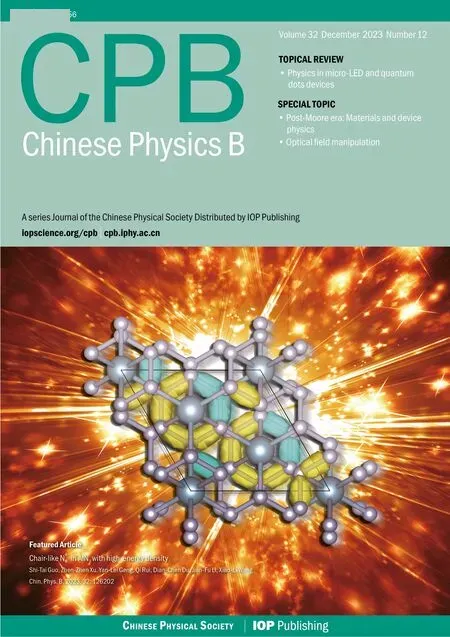The Reissner-Nordstr¨om black hole surrounded by quintessence may not be destroyed
Hao Tang(唐浩) and Jia Zhang(张甲)
1Shaanxi Engineering Research Center of Controllable Neutron Source,Xijing University,Xi’an 710123,China
2School of Physics and Electrical Engineering,Weinan Normal University,Weinan 714099,China
Keywords: weak cosmic censorship conjectures(WCCC),black hole,quintessence,naked singularity
1.Introduction
Penrose proposed the weak cosmic censorship conjectures (WCCC), which mainly assume that the singularity of a black hole is always located inside the event horizon.[1]One could not observe the naked singularity in the universe unless it comes out from the event horizon or the event horizon disappears.This is not allowed in theory.Many papers have studied this important issue.[2-15]Some of them find that by throwing a test particle with particular mass and charge into a black hole, under some idealized conditions such as ignoring the radiation and self-force effects,might cause the disappearance of the event horizon, which would mean that the naked singularity could be observed.[8-12]
For instance,in Ref.[16],the Reissner-Nordstr¨om(RN)black hole could be destroyed by a test particle with particular mass and charge.Yet no naked singularity has ever been observed.Although the authors said that they ignore the radiation and self-force effects,which might protect the black hole from being destroyed, we would like to study the protection scheme in a different way.
As is well known, the expansion of our universe is accelerating, which is supported by some cosmological observations such as those of Type Ia supernovae, the anisotropy of the cosmic microwave background radiation and some x-ray experiments.[17-19]Astrophysicists and cosmologists consider a missing energy component with negative pressure called ‘dark energy’ to be responsible for this accelerating expansion.There are many different candidates for dark energy,[20]such as the cosmological constant,[21]quintessence,[22]chameleons,[23]k-essence,[24]tachyons,[24]phantoms,[26]dilatons[27]and quintoms.[28,29]The differences between these models relate to the magnitude ofωq,which is the ratio of pressure to energy density of dark energy.Black holes surrounded by dark energy are believed to play a crucial role in cosmology.
Of those candidates for the dark energy model,quintessence is defined as an ordinary scalar field coupled to gravity, and by considering Einstein’s field equations for a black hole, charged or not, and surrounded by quintessence,a new solution can be derived related toωq.[30-35]As an ordinary scalar field,the effect on the metric is simpler than for other models.The metric is defined as a scalar field with the equations of a negative state parameter, which is the ratio of pressure and density.Kiselev[35]studied the RN black hole surrounded by quintessence and described some of its properties.Thus,we would like to study a RN black hole surrounded by quintessence to check the WCCC.
This paper is organized as follows.In Section 2,we will calculate the proper mass and charge of the test particle to destroy the black hole, which may cause the disappearance of the event horizon.In Section 3 we will examine the effective potential that might prevent the test particle from falling in.A summary of the work will be given in Section 4.
2.The proper mass and charge of the test particle
For a RN black hole that is surrounded by quintessence(RN-Q),the metric is given as[35]
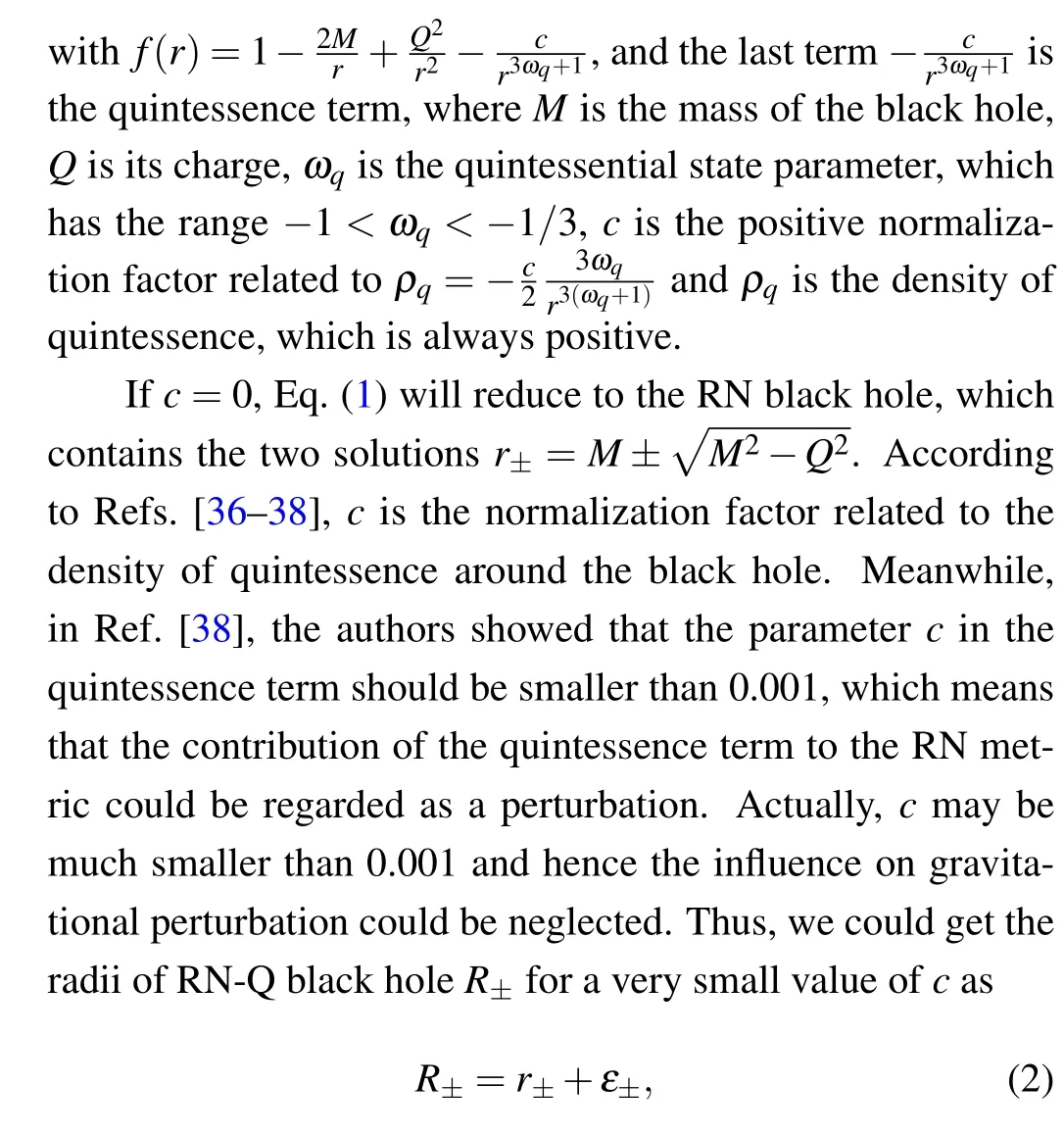
whereε±take the form
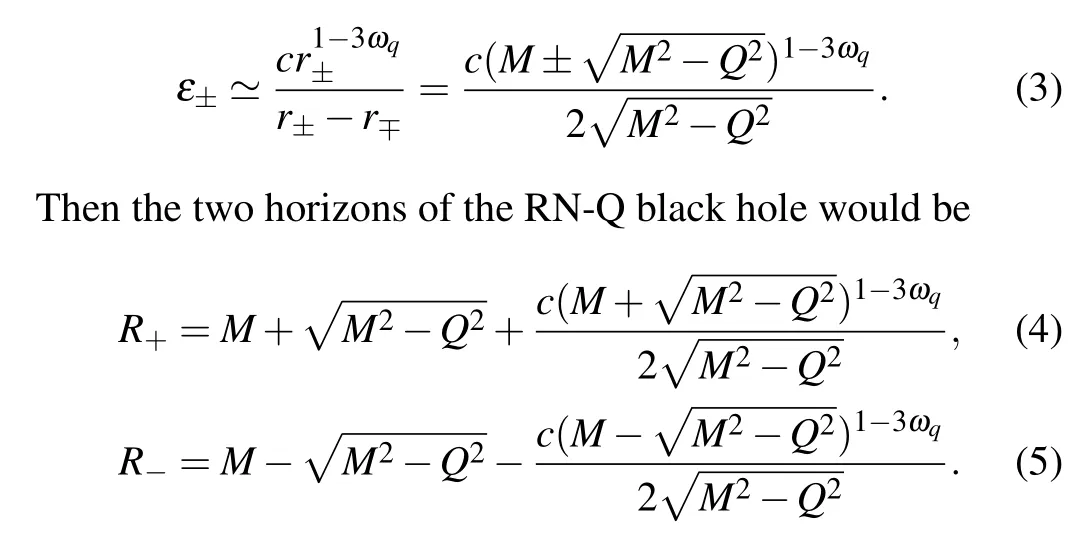
For simplicity, we chooseωq=-2/3 in this paper and setc= 0.0005< 0.001 based on Ref.[38].The choice ofc=0.0005 could make the two horizons much closer to each other in order to achieve the near-extreme condition.Then we have
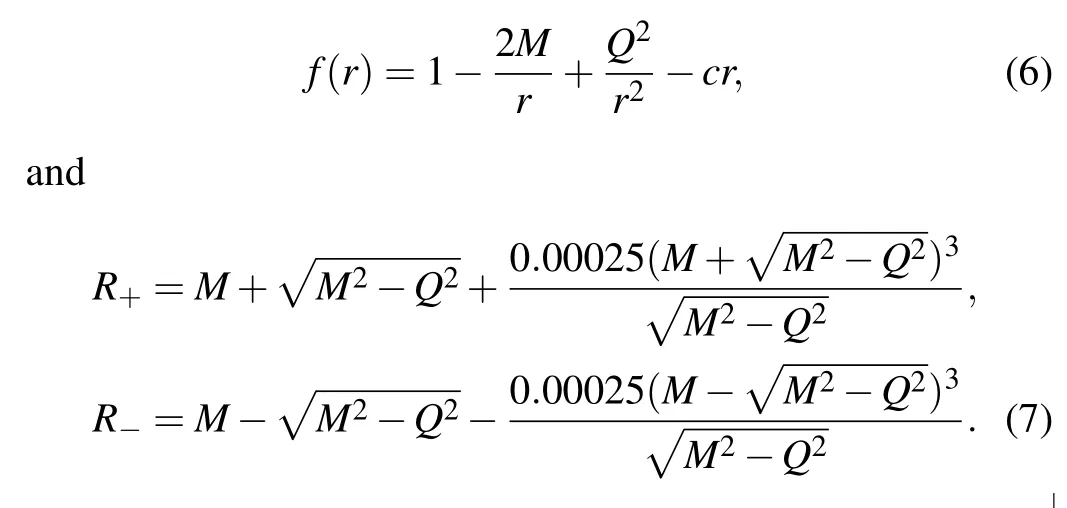
By solving the equationr+=r-, one could get the extreme condition of the RN black hole asM=Q.However,for the RN-Q black hole,we could not get the extreme condition anymore.This means that the extreme RN-Q black hole does not exist rather than that the RN black hole.So we could not study the extreme RN-Q black hole here.
However, because of the small value ofcin Eq.(7), the two horizonsR-andR+would be very close to each other whenMis small enough.We can see this result in Fig.1.Based on this point,we could regard the black hole as a nearextreme black hole whenMis small enough.
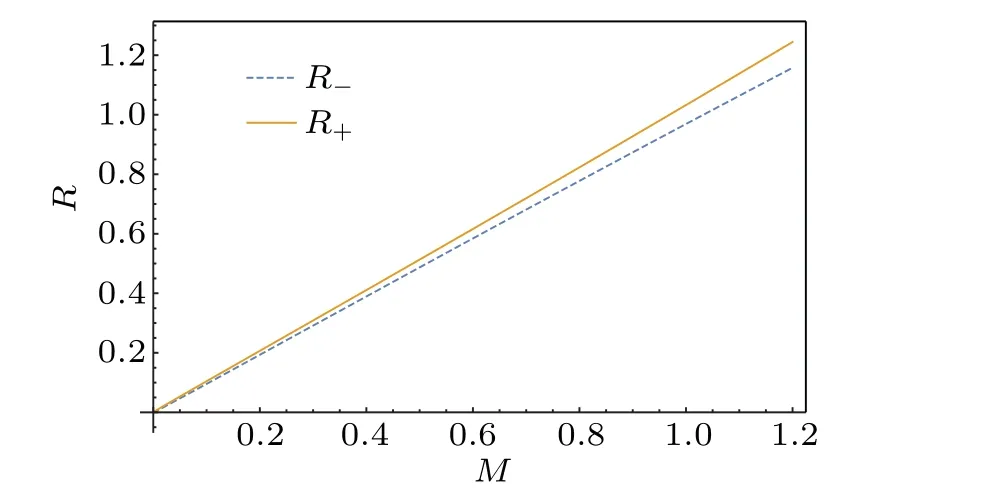
Fig.1.Plot of R- and R+ with mass M. R+ is just a little bigger than R- when M is small enough.
For a near-extreme RN-Q black hole, we could assumeQ=M-δ, whereδ ≪M.This choice ensures thatR-andR+could both be valid and be close to each other.Then Eq.(7)could be written as
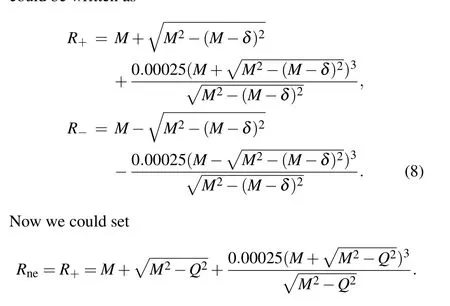
Let us consider a freely falling test particle that moves from infinity to the black hole with massm=Eand chargeq.From Ref.[3], in order to reach the horizon of a black hole,the energy of the test particle should at least satisfy
whereLis the angular momentum of the particle andAtandAφare electromagnetic potentials.For the RN-Q black hole, we have[39]
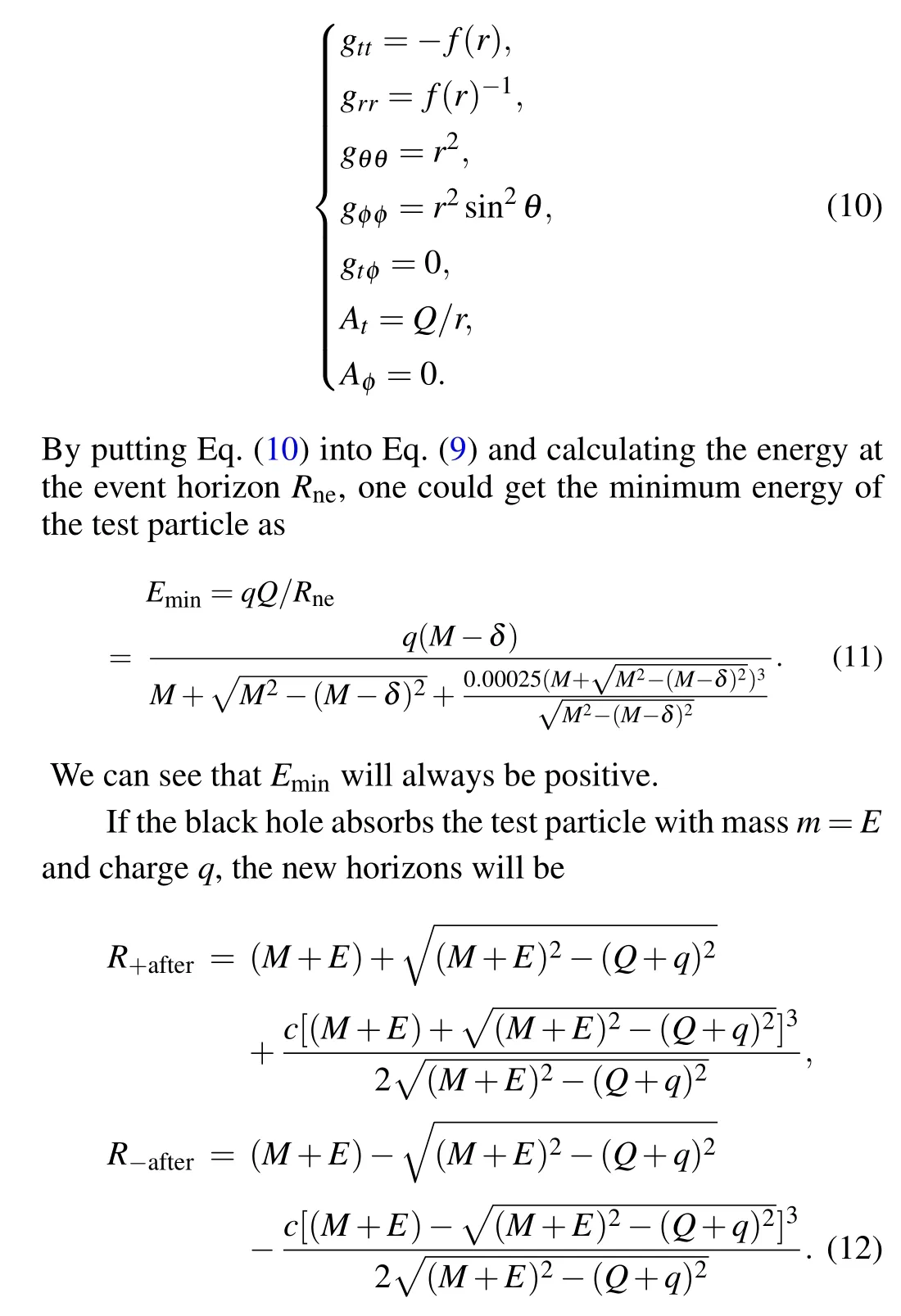
We can see that if(M+E)2-(Q+q)2<0,bothR-afterandR+afterwould vanish, which means the black hole would be destroyed by the test particle.So, in order to destroy the black hole,we need to find the proper massmand chargeqof the test particle.
SinceM+E>0 andQ+q>0,the mass and charge of the test particle need to satisfyE If require ∆E>0, we should choose the proper energy (or mass) of the test particle betweenEminandEmax.Based on this requirement,we could get So, we could setq=qmin+ε, whereεis a very small positive value.Meanwhile,we also requireδ Thus,we could rewrite the expressions forEminandEmax.Since the energy of the particle should be betweenEminandEmax,so we could set the energy as Then, putting the properm=(Emin+Emax)/2 into Eq.(12),one can find that there are no real roots anymore,which means that the black hole has been destroyed. To demonstrate this,we could choose some values to test our result.If we setδ=0.0001, one can get the plot of ∆EwithMandqin Fig.2. Fig.2.Plot of ∆E with M and q.The blue surface is ∆E=0. In Fig.2, one could actually choose many values ofMandqto ensure ∆E>0.This means that for a specific black hole of massM,we could always find a properqto make sure∆E>0.In other words, we could always find a test particle that satisfies the requirements of energy and charge. For instance,if we setδ=0.0001 andM=1.0001,thenQ=M-δ=1 andq=qmin+ε=0.0031594299+ε.Then we have By solving ∆E>0,one could getε>-1.28043×10-11,which means that any small positiveεwould ensure ∆E>0.The chargeqshould satisfyq>0.00315943.By choosing several values ofεto test the result,one can get Table 1. Table 1.Different choices of ε could all cause the horizons to be destroyed. From the results forR-afterandR+after, one can see that we can find the proper test particles to destroy the black hole. However, there is one additional thing we need to consider,which is to check the effective potential.If the effective potential forms a potential barrier that is higher than the energy of the test particle, the particle might not be able to fall into the black hole and thus could not destroy it. For an axisymmetric metric, there exist orbits lying entirely in the equatorial planeθ=π/2.For such an orbit in the RN-Q metric,one could solve Eq.(9)for ˙rand obtain the corresponding effective potentialVeff(r).The effective potential can be regarded as a barrier that lies ahead of the falling particle.The particle cannot fall into the black hole if the effective potential forms a peak that is higher than the energy of the particle.[3]According to Ref.[3], one can express the effective potentialVeff(r)as If we still choose the same parametersc=0.0005,ωp=-2/3,Q=M-δ,q=qmin+ε, and setM=1.0001,δ=0.0001,Q=M-δ=1 andq=qmin+ε=0.0031594299+ε, then we have Putting the six different values ofεandminto Eq.(19), we can obtain Fig.3. One can see that none of the test particles can fall into the black hole.This means that although we could find test particles with the proper mass and charge,there exists a very sharp barrier that stops them from falling in. According to Ref.[16], the RN black hole could be destroyed by choosing a proper test particle with the same method.This means that the quintessential term plays an important role, perhaps even a key role, here.This might be an important result of the function of the quintessence term. Fig.3.Plot of Veff with different ε and m.There exists a sharp potential barrier that stops the particle from falling into the black hole. In summary, by introducing the quintessence term into the RN black hole,we find that a black hole that might otherwise be destroyed may now be‘protected’by the quintessence that surrounds the black hole.This result might show that the quintessence could have more physical meaning than we know of.This is also an interesting effect and result about the WCCC.In order to verify whether this result is universal or not, we would like to study some different black holes in future work. Acknowledgements We thank Dr.Bin Wu and Dr.Cheng-yi Sun for useful comments and enlightening discussions.This work was supported by Foundation Research Project of Shaanxi Province in Natural Science (Grant No.2019JQ-919), Special Project of Education Department of Shaanxi Province in Natural Science(Grant No.20JK0635),and Talent Foundation of Weinan Normal University(Grant No.201120039).
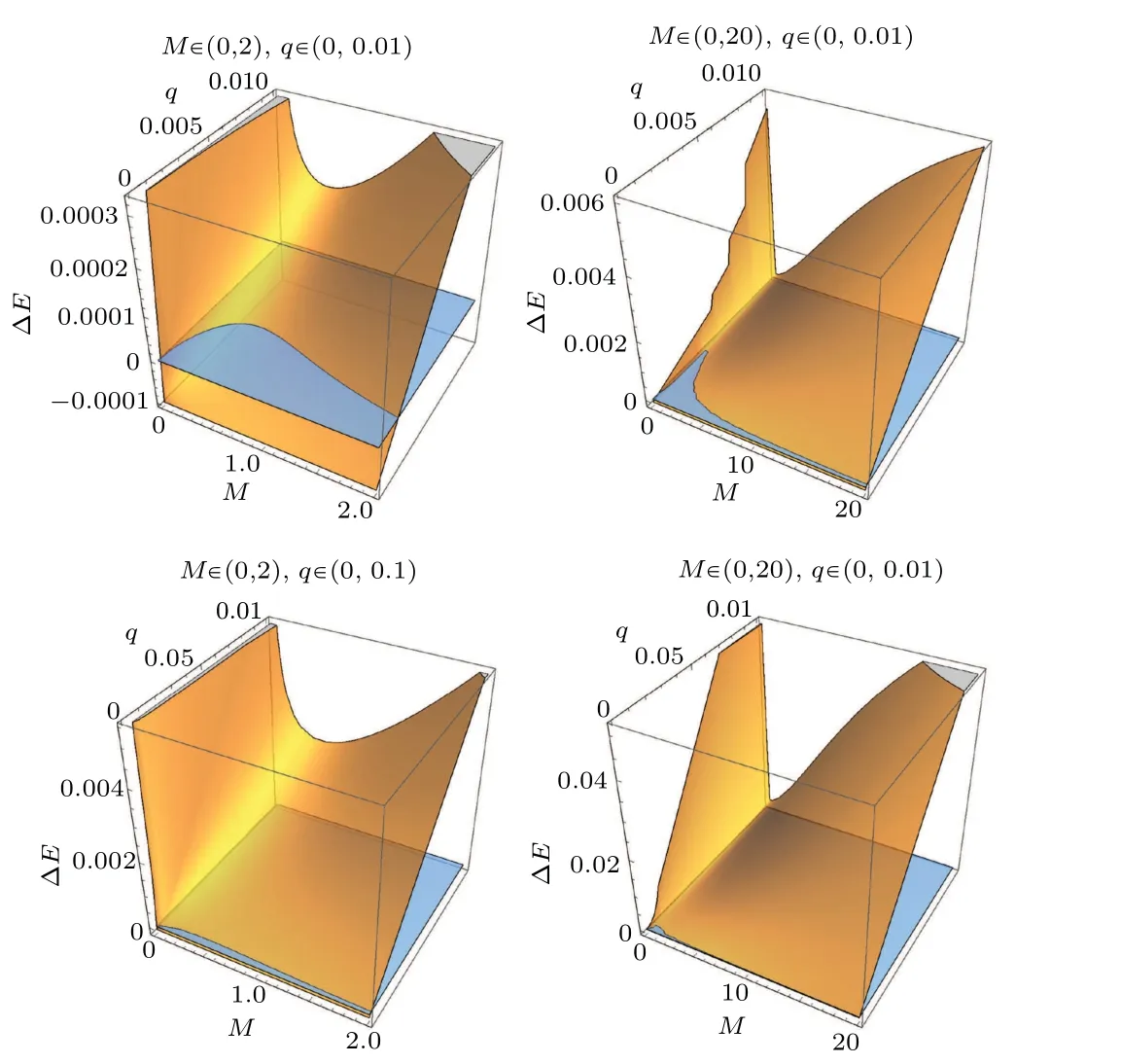

3.The potential barrier

4.Summary

